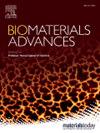Rapid formulation alginate dressing with sustained nitric oxide release: a dual-action approach for antimicrobial and angiogenic benefits
IF 5.5
2区 医学
Q2 MATERIALS SCIENCE, BIOMATERIALS
Materials Science & Engineering C-Materials for Biological Applications
Pub Date : 2025-05-19
DOI:10.1016/j.bioadv.2025.214350
引用次数: 0
Abstract
Infected chronic wounds resulting from bacterial, viral, or other microbial invasion disrupt the normal wound-healing process, often prolonging recovery and requiring surgical intervention. A high nitric oxide (NO) concentration damages bacterial DNA and disrupts metabolic functions, indicating its effective antibacterial potential, whereas a low NO concentration exerts detectable provascularization activity. These properties render NO an effective treatment agent for infected chronic wounds. However, challenges remain in generating NO efficiently, controlling its dosage, and selecting an appropriate carrier for wound treatment. To overcome these problems, we synthesized S-nitrosoglutathione (GSNO) and thiolated alginate (SA-SH). GSNO was used as the NO source for continuous release. The content of the thiolate group in SA-SH was 158.10 ± 10.84 μmol/g. The GSNO and SA-SH mixture was quickly solidified in the presence of calcium ions to obtain GSNO/SA-SH hydrogel (SSG). This mixture is suitable for treating irregular wounds. In addition, early release of high-dose NO inhibits bacteria (first 72 h), whereas late release of low-dose NO promotes angiogenesis (72–144 h). Experiments conducted on a rat infection model showed that the release of NO reduced infection and effectively inhibited bacterial invasion of tissues. On the 14th day after surgery, the healing rate of the control group was 82 %, whereas that of the SSG group was 100 %. The degree of angiogenesis in the SSG group was 1.5 times that in the SA-SH group, indicating that NO accelerates angiogenesis. Thus, a rapid-forming, NO releasing dressing can effectively treat infected wounds.
快速配方海藻酸盐敷料持续一氧化氮释放:抗菌和血管生成的双重作用方法
由细菌、病毒或其他微生物入侵引起的慢性伤口感染会破坏正常的伤口愈合过程,通常会延长恢复时间并需要手术干预。高一氧化氮(NO)浓度会破坏细菌DNA并破坏代谢功能,表明其有效的抗菌潜力,而低一氧化氮浓度则具有可检测的促血管活性。这些特性使一氧化氮成为慢性伤口感染的有效治疗剂。然而,在有效地产生一氧化氮、控制其剂量和选择合适的载体进行伤口治疗方面仍然存在挑战。为了克服这些问题,我们合成了s -亚硝基谷胱甘肽(GSNO)和硫代海藻酸盐(SA-SH)。以GSNO为NO源持续释放。SA-SH中巯基含量为158.10±10.84 μmol/g。将GSNO和SA-SH混合物在钙离子存在下快速固化,得到GSNO/SA-SH水凝胶(SSG)。这种合剂适合治疗不规则伤口。此外,高剂量NO的早期释放可抑制细菌(前72 h),而低剂量NO的晚期释放可促进血管生成(72 - 144 h)。在大鼠感染模型上进行的实验表明,NO的释放减少了感染,有效地抑制了细菌对组织的侵袭。术后第14天,对照组的愈合率为82%,而SSG组的愈合率为100%。SSG组血管生成程度是SA-SH组的1.5倍,说明NO加速了血管生成。因此,一种快速成型、释放一氧化氮的敷料可以有效地治疗感染伤口。
本文章由计算机程序翻译,如有差异,请以英文原文为准。
求助全文
约1分钟内获得全文
求助全文
来源期刊
CiteScore
17.80
自引率
0.00%
发文量
501
审稿时长
27 days
期刊介绍:
Biomaterials Advances, previously known as Materials Science and Engineering: C-Materials for Biological Applications (P-ISSN: 0928-4931, E-ISSN: 1873-0191). Includes topics at the interface of the biomedical sciences and materials engineering. These topics include:
• Bioinspired and biomimetic materials for medical applications
• Materials of biological origin for medical applications
• Materials for "active" medical applications
• Self-assembling and self-healing materials for medical applications
• "Smart" (i.e., stimulus-response) materials for medical applications
• Ceramic, metallic, polymeric, and composite materials for medical applications
• Materials for in vivo sensing
• Materials for in vivo imaging
• Materials for delivery of pharmacologic agents and vaccines
• Novel approaches for characterizing and modeling materials for medical applications
Manuscripts on biological topics without a materials science component, or manuscripts on materials science without biological applications, will not be considered for publication in Materials Science and Engineering C. New submissions are first assessed for language, scope and originality (plagiarism check) and can be desk rejected before review if they need English language improvements, are out of scope or present excessive duplication with published sources.
Biomaterials Advances sits within Elsevier''s biomaterials science portfolio alongside Biomaterials, Materials Today Bio and Biomaterials and Biosystems. As part of the broader Materials Today family, Biomaterials Advances offers authors rigorous peer review, rapid decisions, and high visibility. We look forward to receiving your submissions!

 求助内容:
求助内容: 应助结果提醒方式:
应助结果提醒方式:


